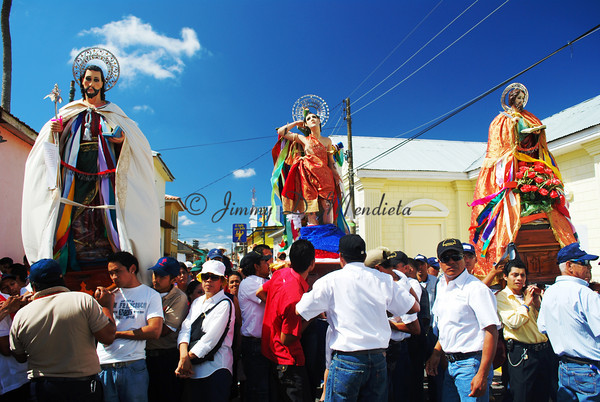Santiago's Miracle
On the 20th of January of every year, the “Fiestas de San Sebastián” (Festival of Saint Sebastian) is celebrated in the city of Diriamba. The festival starts, the day before, with the popular procession “El Tope”, similar to the one that takes place during the “Fiestas de Santiago” (Festival of Santiago), the difference is that in Diriamba they are of a more colorful nature due to their folkloric dances. The procession of “El Tope” enters the town through the “Torre del Reloj” (a street with a distinctive “Clock Tower”). On the door steps of their homes, families, gather in silence to contemplate the passing of the procession that slowly drowns itself in the noise of the afternoon’s landscape. In one door was the Briceño family with their soul drenched in devotion. There is Martha holding her mother’s hand. With a childish sweetness in her sad and hopeful gaze she prays that the lord lay his divine hand on her head. Martha suffers of child paralysis. One of her legs can only function with the help of crutches and an orthopedic system. Doctors say there isn’t any possible recovery. There could be a slight improvement but she would always have a pronounced sequel of the disease. In front of the girl passes Saint Sebastian with his agonizing eyes and his blue body filled with arrows that embed themselves between the carnations and roses. All of his body reminds us of the painful verse painted by “La Seguidilla Gitana”.He started sweating pure blood From suffering so much pain, And he took the lilies color On his saintly martyr body.
From his emerald eyes, By his sunshine little face Dripping like bright stars, The tears of pain.
Santiago passes irradiating eternal light and so did Saint Marcus all meek and serene like a soft aroma. The three of them leave metallic notes on the streets that cut into pieces and on the sidewalks a market of sliced plantain and fried pork. The sweet smile from the girl when the saints pass is a garden of hope. Her faith, like a huge dove, looks at the beloved saints that pass on the shoulders of their devoted. She is impressed with the air transformed with flutes and drums, with fireworks that scream and whistle between the houses, with mirror dances, masks, feathers swords and fans, with the muttering of the crowd that paint the streets with colors, with the kneeling penitents that with their divine penance wish to see the end of their promise, and with the amount of offerings which converts January into “Indio Viejo”, “buñuelos” and “Chicha” (these are traditional foods and drinks). At night, the girl leaves her crutches and removes from her leg the orthopedic system to go to sleep. With a Franciscan tenderness, she dreams of the noisy procession that passes in front of her house. And sees the good and loving image of Santiago that looks at her and with a voice that comes from the stars, says to her: “Pass my flowers over your little leg”. The girl sees this over and over again, and she sees herself spreading flowers from the Patron over her sick leg. In the morning, she tells her dream to her mother. Her mother, a noble lady with the body and soul of a diriambina, did not understand how the Patron from Jinotepe and not Saint Sebastian would appear in her daughter’s dreams. So over and over she would ask her: —My daughter, search deep in your dreams which saint offered you flowers for your leg. The little girl repeating over and over, answered: —It was the tall and beautiful Saint with the low beard from Jinotepe that was accompanying Saint Sebastian. More proof is needed. They take the girl to the church so she can see all three Saints and she can point out the one that appeared in her dreams. She looks at all three. The captive fragrance from the image of Santiago goes down to the girl and, filled with joy like when one has found an old friend, she points with her little finger and exclaims: “It’s him!” Her mother kneels down at the image of Santiago. Sows a prayer, takes some flowers from his feet and passes the glorious flowers on her daughter’s sick leg. Days pass and the girls recovery is evident. A luminous laughter reaches into her bone marrow and the sadness in her eyes turn to a festival of lights. She doesn't need her crutches anymore and she can run through the fields getting nests and fruits covered with dust from her footsteps. The orthopedic system is taken off and the crutches are stored far away. It’s a total recovery. The rumor of the miracle runs through nearby villages, Jinotepe gets into a soft protest towards their Patron that seems to say: Great! You have become light of the streets and darkness of the house. The Apostle looks with the tenderness of a concealed smile at his village and to show them he remains the same, he continues closing wounds when adversity strikes at his hart, the hundreds of ribbons swaying in his hands, and every day an increasing number of promised people walk through the asphalt streets on their reddish knees in thanks of the miracles they have received. This tale was taken from the book “El Patrón Santiago” written by Dr. Armando Luna Silva, beloved son of the city of Jinotepe; lawyer, diplomat and writer. In a conversation that we had with DR. Luna he gave us his consent to publish this captivating and passionate story. Our sincerest thanks to Dr. Armando Luna Silva!


Pingback: Milagro de Santiago | Nicaragua Linda